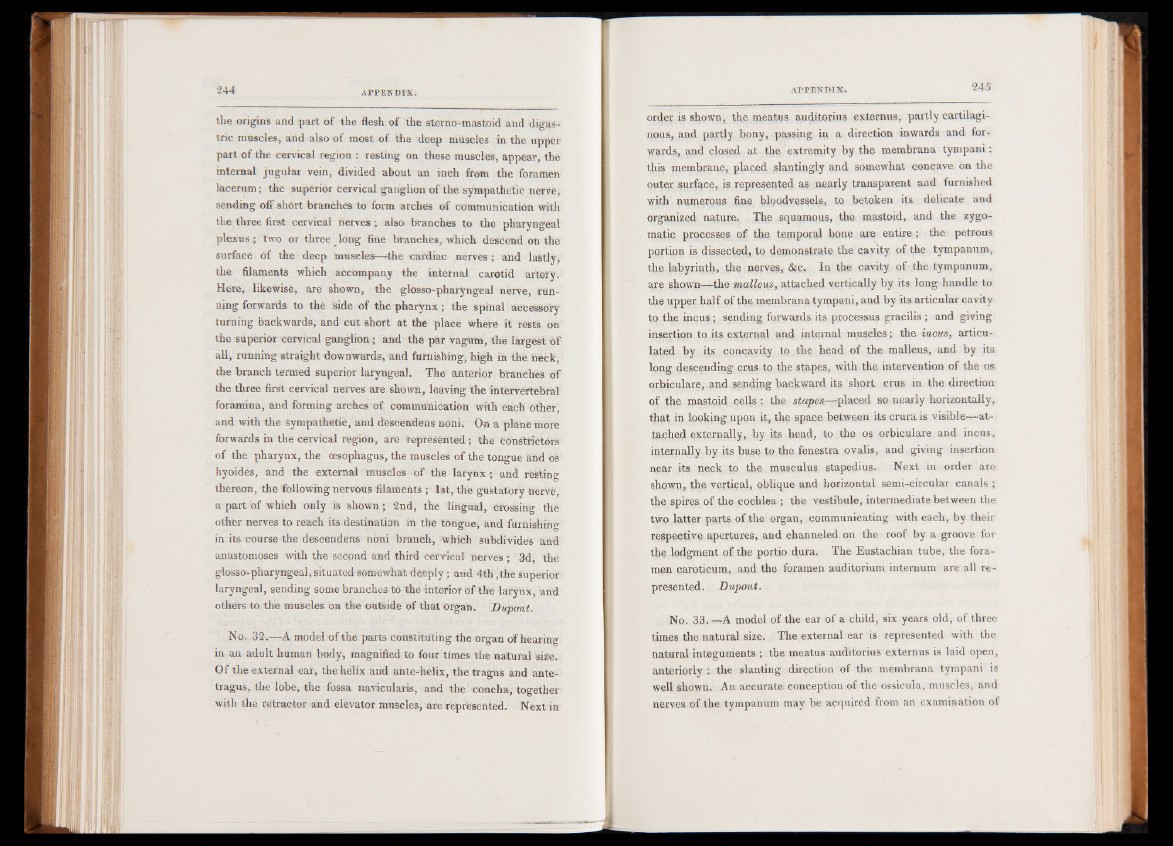
tlie origins and part of the flesh of the sterno-mastbid and digastric
muscles, and also of most of the deep muscles in the upper
part of the cervical region : resting on these muscles, appear, the
internal jugular vein, divided about an inch from the foramen
lacerum; the superior cervical ganglion of the sympathetic nerve,
sending off short branches to form arches of communication with
the three first cervical nerves ; also branches to the pharyngeal
plexus ; two or three long fine blanches, which descend on the
surface of the deep museles—the cardiac nerves ; and lastly,
the filaments which accompany the internal carotid artery.
Here, likewise, are shown, the glosso-pbaryngeal nerve, running
forwards to the side of the pharynx ; the spinal accessory
turning backwards, and cut short at the place where it rests on
the superior cervical ganglion ; and the par vagum, the largest of
all, running straight downwards, and furnishing, high in the neck,
the branch termed superior laryngeal. The anterior brânclïes of
the three first cervical nerves are shown, leaving the intervertebral
foramina, and forming arches of communication with each other,
and with the sympathetic, and dèscendens noni. On a plane more
forwards in the cervical region, are represented’; the Constrictors
of the pharynx, the oesophagus, the muscles of the tongue and os
hyoïdes, and the external muscles of the larynx ; and resting
thereon, the following nervous filaments ; 1 st, the gustatory nerve,
a part of which only is shown ; 2nd, the lingual, crossing the
other nerves to reach its destination in the tongue, and furnishing
in its course the descendens noni branch, which subdivides and
anastomoses with the second and third Cervical nerves ; 3d the
glosso-pharyngeal, situated somewhat deeply ; and 4th ,the Superior
laryngeal, sending some branches to the interior of the larynx, and
others to the muscles on the outside of that organ. Dupont.
No. 32.—A model of the parts constituting the organ of hearing
in an adult human body, magnified to four times the natural size.
Of the external ear, the helix and ante-helix, the tragus and ante-
tragus, the lobe, the fossa navicularis, and the concha, together
with the retractor and elevator muscles, are represented. Next in
order is shown, the meatus auditorius externus, partly cartilaginous,
and partly bony, passing in a direction inwards and forwards,
and closed at the extremity by the membrana tympani:
this membrane, placed slantingly and somewhat concave on the
outer surface, is represented as nearly transparent and furnished
with numerous fine bloodvessels, to betoken its delicate and
organized nature. The squamous, the mastoid, and the zygomatic
processes of the temporal bone are entire; the petrous
pqj-tion is dissected, to demonstrate the cavity of the tympanum,
the labyrinth, the nerves, &c. In the cavity of the tympanum,
are shown—the malleus, attached vertically by its long handle to
the upper half of the membrana tympani, and by its articular cavity
to the incus; sending forwards its processus gracilis ; and giving
insertion to its external and internal muscles; the incus, articulated
by its concavity to the head of the malleus, and by its
long descending crus to the stapes, with the intervention of the os
orbiculare, and sending backward its short crus in the direction
of the mastoid cells : the stapes—placed so nearly horizontally,
that in looking upon it, the space between its crura is visible—attached
externally, by its head, to the os orbiculare and incus,
internally by its base to the fenestra ovalis, and giving insertion
near its neck to the musculus stapedius. Next in order are
shown, the vertical, oblique and horizontal semi-circular canals ;
the spires of the cochlea ; the vestibule, intermediate between the
two latter parts of the organ, communicating with each, by their
respective apertures,.and channeled on the roof by a groove for
the lodgment of the portio dura. The Eustachian tube, the foramen
caroticum, and the foramen auditorium internum are all represented.
Dupont.
No. 3 3 . —A model of the ear of a child, six years old, of three
times the natural size. The external ear is represented with the
natural integuments ; the meatus auditorius externus is laid open,
anteriorly : the slanting direction of the membrana tympani is
well shown. An accurate conception of the ossicula, muscles, and
nerves of the tympanum may be acquired from an examination of